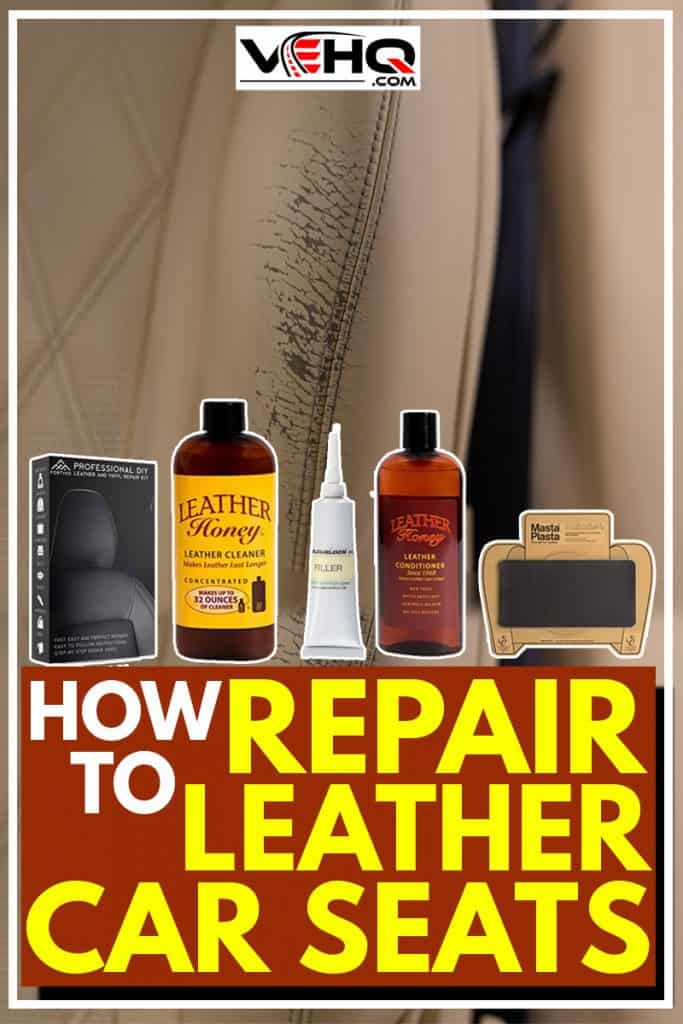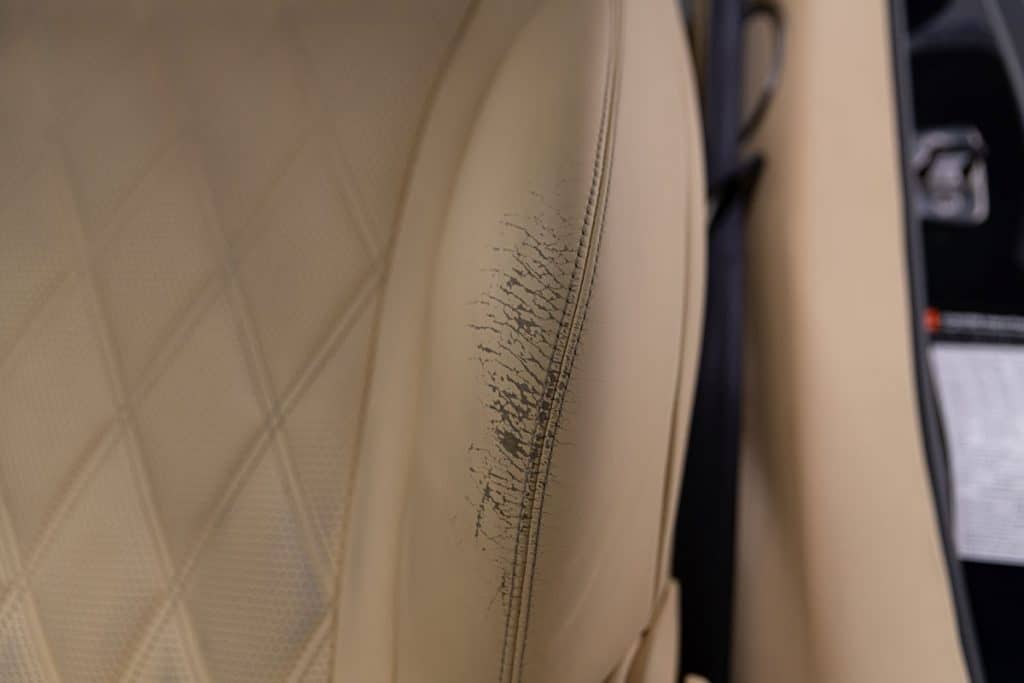 Leather upholstery gives your car’s interior luxurious comfort. With a bit of extra care, leather upholstery can look and feel like new for years to come. But, if you’ve discovered an unintended hole or rip in the upholstery, how do you repair leather car seats? We’ve got the answer to keep you in your leather seats.
Leather upholstery gives your car’s interior luxurious comfort. With a bit of extra care, leather upholstery can look and feel like new for years to come. But, if you’ve discovered an unintended hole or rip in the upholstery, how do you repair leather car seats? We’ve got the answer to keep you in your leather seats.- Thoroughly clean the damaged area.
- Examine the damage and carefully trim away any loose stitching or ragged edges.
- Select either a leather repair kit or patch.
- Match either the repair kit’s colorant or the color of the patch to the color of your leather upholstery.
- Follow the instructions provided by the repair kit to apply filling material. This might require the application of several thin layers to fill/seal the damaged area. If using a patch, follow the instructions provided by the adherent to apply the patch.
- If you’ve applied filling material, let the material dry completely, and continue with step #6. If you’ve adhered a patch, let the adhesive dry completely and proceed to step #10.
- Sand the filled area with a fine-grit sandpaper.
- Clean the sanded area using a damp cloth to remove any dust or debris.
- Follow the instructions provided with the leather repair kit to apply colorant. This might require the application of several thin layers to match the color of your leather upholstery accurately.
- Let the colorant dry completely.
- Apply leather conditioner.
Keep reading to take a closer look at this leather repair process, so you will know precisely how to repair a hole or rip in your car’s leather seats.
How do You Fix a Rip in a Leather Car Seat?
Taking the time to repair a leather car seat yourself not only saves you money but also avoids irreparable damage to the seat in the long run.
Clean the Damaged Areas
First, thoroughly clean the area using a leather-specific cleanser and soft bristle brush. If you do not have a leather cleanser, you might try Leather Honey all-natural leather cleaner.
Click here to find this on Amazon.
Choose A Repair Kit and Match the Color
Next, you will want to choose a leather repair kit with a colorant that closely matches your leather upholstery. Matching the color conceals the repair, so you’ll never even notice it happened. Fortivo’s Leather and Vinyl Repair kit lets you mix colors for the perfect match or choose from black, brown, or white colorant kits.
Click here to find this on Amazon.
Carefully Follow the Instructions
Closely follow the instructions provided by the leather repair kit. Using a pallet knife, apply thin layers of filling material to the seat's backing cloth beneath the edges of the rip. The filling material will not close the edges of the split together but will act as a seal to keep the leather from ripping more. Let the filling material dry completely.
Lightly Sand the Filled Area, Clean, and Let Dry
Lightly sand the filled area with a fine-grit sandpaper. Clean the remaining dust or debris with a damp cloth. Now, you can follow the instructions on the leather repair kit to mix and apply colorant. It might take several thin layers of colorant to match your leather upholstery correctly. Let the colorant dry completely between each layer.
Apply Leather Conditioner
Finish your leather repair by applying a leather conditioner to the upholstery. If you liked Leather Honey’s Leather Cleaner, you could also try Leather Honey Leather Conditioner.
Click here to find this on Amazon.
How to Use a Patch for Leather Repair?
A leather patch is useful to repair small holes in your car’s upholstery. Prepare the damaged area in the same manner as we’ve explained for repairing a rip. Thoroughly clean the upholstery, examine and trim the damaged area. Next, choose your patch.
For a patch, you can use a spare swatch of leather that came with your car, a piece of your car’s upholstery cut from beneath the seat, or a dyed swatch of leather to match the color of your car’s upholstery. Masta Plasta’s leather patch kits come in a variety of colors.
Click here to find this on Amazon.
You will want to cut the patch slightly larger than the hole. Follow the instructions provided with the patch kit or adhesive to apply the patch. It’s a good idea to slip a piece of wax paper inside the upholstery, behind the hole, to prevent the adhesive from sticking to the cloth interior of the seat.
Let the adhesive dry completely. Finish your repair by applying a leather conditioner to the upholstery.
Does Fabric Glue Work on Leather?
Fabric glue is a versatile adhesive capable of mending a variety of flexible materials such as vinyl, jean, and leather. You can use fabric glue to adhere to a leather patch to repair damaged leather upholstery.
You should always wear gloves to protect your skin when working with adhesives. Follow the instructions provided by the glue for a successful application.
Is Gorilla Glue Good for Leather?
Gorilla glue can be used for leather. But it is not a good solution. Gorilla glue is a polyurethane-type glue that will form a powerful bond once set. However, polyurethane glues are not good gap-fillers, making Gorilla glue a less than ideal choice for leather’s flexible, uneven surfaces.
What is the Best Adhesive for Leather?
Shoe glue is a durable, flexible adhesive that can be used to repair damaged leather. Similar to fabric glue, shoe glue forms strong bonds on a variety of materials. Still, it also has gap-filling properties that make it ideal for bonding to leather’s imperfect surfaces.
As we’ve previously cautioned, you should always wear gloves to protect your skin when working with adhesives. Carefully follow instructions provided by the adhesive.
What Causes Leather to Crack?

Leather is a natural product' it was once living skin. Complex microfibers that comprise leather were kept replenished by the skin’s natural oils. These oils kept the microfibers durable and flexible. But, leather products do not contain natural oils and so the microfibers slowly dry out. Eventually, dried microfibers will break, resulting in a visible crack in the leather.
Exposure to the sun’s UV rays can expedite the leather’s drying process. Keeping your car’s leather upholstery covered from direct sunlight will improve the longevity of your leather.
If you are now wondering can you put seat covers on leather seats, the answer is yes. Seat covers protect your leather upholstery from sun damage, scratches, spills, and dirt.
How Do You Rehydrate Leather?
Can Cracked Leather be Repaired?
How Much Does it Cost to Repair a Leather Car Seat?
A DIY leather repair for your car seats can cost as little as $20 to as much as $200. It all depends on the size of the damaged area and the cost of the materials you will need to complete the job. A small amount of fill for a rip or a crack will go a long way versus the alternative cost of professionally reupholstering the seats, ranging from $200 to $700 per seat.
As you can imagine, you can spend a small fortune on your car’s leather interior. But, keeping that new car smell and long-lasting, supple leather is as simple with a bit of tender care.





